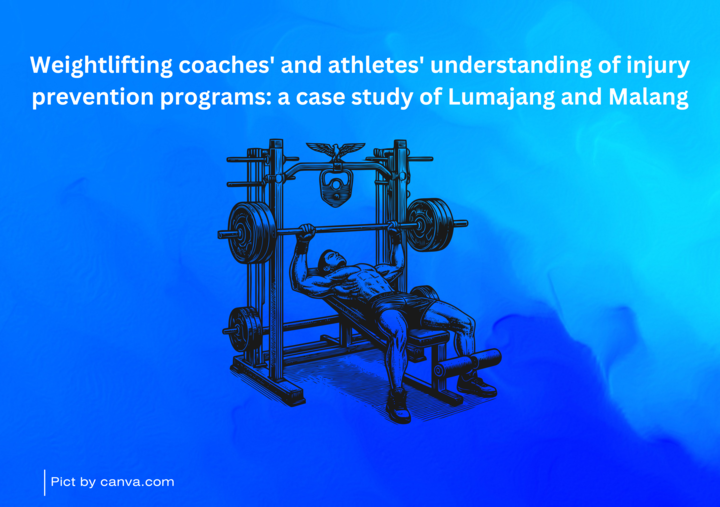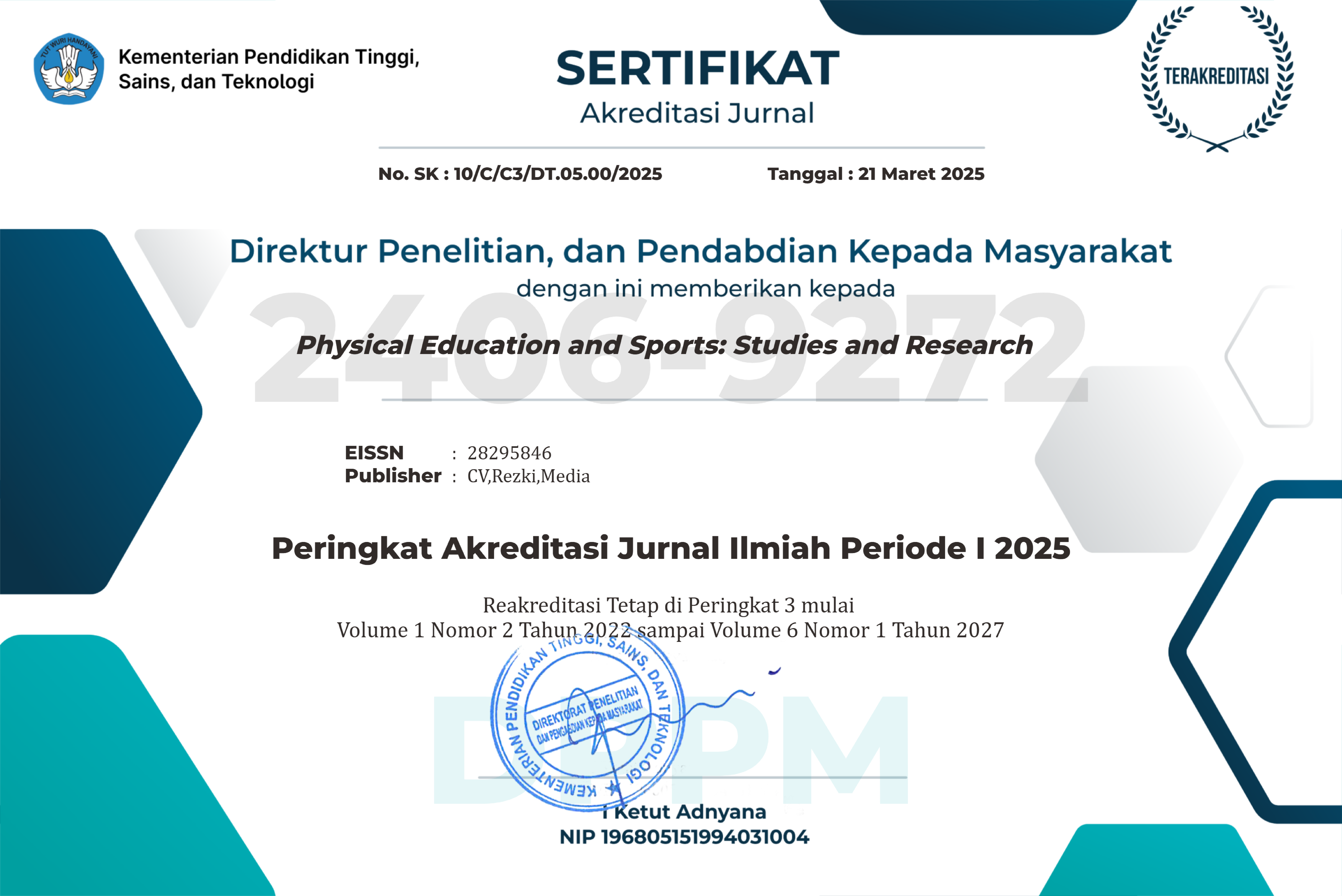Weightlifting coaches' and athletes' understanding of injury prevention programs: a case study of Lumajang and Malang

Downloads
Background: Weightlifting is a high-intensity sport with a high risk of injuries due to improper technique, insufficient warm-up, and excessive training loads.
Objectives: This study explores the understanding, strategies, and barriers of weightlifting coaches and athletes in Lumajang District and Malang City related to implementing injury prevention programs in performance sports.
Methods: This study used a qualitative case study approach. Participants were selected using purposive sampling, consisting of weightlifting coaches with at least one year of experience and athletes who had trained and competed at the regional level. Data were collected through interviews, observations, and document analysis, while data were analyzed using the Miles and Huberman model, including reduction, presentation, and conclusion.
Results: The results showed that coaches and athletes emphasized dynamic warm-ups, core and back strengthening exercises, and correct lifting techniques as the main strategies to prevent injuries. However, limitations in facilities, literature access, and training variety were identified as barriers to implementing optimal injury prevention programs.
Conclusions: This study concludes that effective injury prevention in weightlifting requires structured warm-up routines, individualized training programs, and adequate supporting equipment. Strengthening coaches’ knowledge and providing better facilities are crucial to minimize injuries and enhance athlete performance.Ambardini, R. L., & Kushartanti, B. W. (2024). Optimizing recovery: how PNF stretching and ice massage alleviate markers of DOMS?. Retos, 58, 560-567. https://doi.org/10.35975/retos.v4i1.429051
Bahr, Roald., & Engebretsen, Lars. (2009). Sports injury prevention. Wiley-Blackwell.
Bayati, R., Majelan, A. S., Mirzaei, B., & Barbas, I. (2019). The effect of 12 weeks of Wrestling+ warm-up program on Functional Movement Screen scores in cadet Wrestlers. Annals of Applied Sport Science, 7(1), 39–47. https://doi.org/10.29252/aassjournal.7.1.39
Behm, D. G., Kay, A. D., Trajano, G. S., & Blazevich, A. J. (2021). Mechanisms underlying performance impairments following prolonged static stretching without a comprehensive warm-up. European journal of applied physiology, 121(1), 67-94. https://doi.org/10.1007/s00421-020-04538-8
Bizzini, M., & Dvorak, J. (2015). FIFA 11+: an effective programme to prevent football injuries in various player groups worldwide—a narrative review. British journal of sports medicine, 49(9), 577-579. https://doi.org/10.1136/bjsports-2015-094765
Blazevich, A. J., Gill, N. D., Kvorning, T., Kay, A. D., Goh, A. G., Hilton, B., Drinkwater, E. J., & Behm, D. G. (2018). No Effect of Muscle Stretching within a Full, Dynamic Warm-up on Athletic Performance. Medicine and Science in Sports and Exercise, 50(6), 1258–1266. https://doi.org/10.1249/MSS.0000000000001539
Buitrago, M., & Jianping, M. (2018). Chinese weightlifting: technical mastery and training. Amherst: Ma Strength: LLC.
Creswell. (2013). Qualitative Inquiry And Research Design_Choosing Among Five Approaches.
De Ste Croix, M., Ayala, F., Sanchez, S. H., Lehnert, M., & Hughes, J. (2020). Grass-root coaches knowledge, understanding, attitude and confidence to deliver injury prevention training in youth soccer: a comparison of coaches in three EU countries. Journal of Science in Sport and Exercise, 2(4), 367-374. https://doi.org/10.1007/s42978-020-00075-0
Edouard, P., & Ford, K. R. (2020). Great challenges toward sports injury prevention and rehabilitation. Frontiers in sports and active living, 2, 566015. https://doi.org/10.3389/fspor.2020.00080
Feng, G. (2024). Sports Injury Prevention and Rehabilitation in Physical Training. http://www.stemmpress.com
Gabbett, T. J., Kennelly, S., Sheehan, J., Hawkins, R., Milsom, J., King, E., Whiteley, R., & Ekstrand, J. (2016). If overuse injury is a ‘training load error’, should undertraining be viewed the same way?. British Journal of Sports Medicine, 50(17), 1017-1018. https://doi.org/10.1136/bjsports-2016-096308
Hanief, Y. N., Azidin, R. M. F. R., Sumartiningsih, S., & Firmansyah, A. (2025). The effect of 12 times training of the FIFA 11+ on fundamental movements in football academy athletes aged 14-17 as an effort to prevent injury. Sportis. Scientific Journal of School Sport, Physical Education and Psychomotricity, 11(2), 1-18. https://doi.org/10.17979/sportis.2025.11.2.11354
Hanief, Y. N. ., Azidin, R. M. F. R., & Supriatna, S. (2025). Pelatih hebat, pemain kuat: program penguatan latihan kekuatan di Batu Football Academy. Darmabakti: Jurnal Pengabdian Kepada Masyarakat, 1(1), 32-39. https://doi.org/10.56003/darmabakti.v1i1.426
Hasan, M. F., Solikah, N. L., Fathannisa, T. B., Apriantono, T., Ramania, N. S., Pambudi, Y. T., & Firmansyah, A. (2024). Characteristics of injury to weightlifting athletes in Indonesia. Retos, 59, 349-354. https://doi.org/10.47197/retos.v59.103480
Ibn, A., & Fazal, A. (2023). Injury Prevention Protocol for Tennis Elbow. https://doi.org/10.13140/RG.2.2.24493.97765
Kancherla, A. S. (2023). Delayed Onset Muscle Soreness (DOMS): Management Update. Annals of Innovation in Medicine, 1(3). https://doi.org/10.59652/aim.v1i3.79
Kirichenko, V. (2024). Injury prevention of student volleyball players aged 18-21. Health-Saving Technologies, Rehabilitation and Physical Therapy, 5(1), 37–48. https://doi.org/10.58962/HSTRPT.2024.5.1.37-48
Kirkendall, D. T., Junge, A., & Dvorak, J. (2010). Prevention of football injuries. Asian journal of sports medicine, 1(2), 81-92. https://doi.org/10.5812/asjsm.34869
Maestroni, L., Read, P., Bishop, C., & Turner, A. (2020). Strength and power training in rehabilitation: underpinning principles and practical strategies to return athletes to high performance. Sports Medicine, 50(2), 239-252. https://doi.org/10.1007/s40279-019-01195-6
Mendonça, L. D., Schuermans, J., Wezenbeek, E., & Witvrouw, E. (2021). Worldwide sports injury prevention. International Journal of Sports Physical Therapy, 16(1), 285–287. https://doi.org/10.26603/001c.18700
Miles, M. B., Huberman, A. M., & Saldana, J. (2014). Qualitative data analysis: A methods sourcebook.
Mu’arifin, Kurniawan, A. W., & Abdullah, A. (2019). Pelatihan Penanganan Dan Pencegahan Cedera Untuk Pelatih Cabang Olahraga Koni Kota Batu. Jurnal Sport Science, 9(2), 158-162.
Ningning, Y. (2023). Strength training for injury prevention in aerobic gymnastics. Revista Brasileira de Medicina do Esporte, 29, e2022_0517. https://doi.org/10.1590/1517-8692202329012022_0517
Potach, D., & Meira, E. (2022). Sport injury prevention anatomy. Human Kinetics.
Reid, J. C., Greene, R., Young, J. D., Hodgson, D. D., Blazevich, A. J., & Behm, D. G. (2018). The effects of different durations of static stretching within a comprehensive warm-up on voluntary and evoked contractile properties. European Journal of Applied Physiology, 118(7), 1427–1445. https://doi.org/10.1007/s00421-018-3874-3
Sumartiningsih, S., Rahayu, S., Setiowati, A., Risdiyanto, A., Syahputri, W. R., Abiyu, R., Anas, S. A. I., Fauzi, I., Puspita, M. A., Ariyatun, A., & Gunawan, G. (2023). Edukasi Pencegahan Cedera Olahraga Melalui Warming Up FIFA 11+. Journal of Community Empowerment, 3(1), 50–54. https://journal.unnes.ac.id/sju/index.php/jce50
Sumartiningsih, S., Risdiyanto, A., Yusof, A., Rahayu, S., Handoyo, E., Puspita, M. A., Sugiharto, Mukarromah, S. B., Hooi, L. B., Lubis, J., Hanief, Y. N., Festiawan, R., & Eiberger, J. (2022). The FIFA 11+ for kids warm-up program improved balance and leg muscle strength in children (9–12 years old). Journal of Physical Education and Sport, 22(12), 3122–3127. https://doi.org/10.7752/jpes.2022.12395
Wang, H. (2024). Prevention and Rehabilitation Training Strategies for Knee Injuries in Basketball. Journal of Modern Medicine and Nursing, 1(2). https://doi.org/10.70767/jmmn.v1i2.284
Wu, S., & Luo, X. (2022). [Retracted] Prevention and Treatment of Sports Injuries and Rehabilitative Physical Training of Wushu Athletes. Applied Bionics and Biomechanics, 2022(1), 2870385. https://doi.org/10.1155/2022/2870385
Copyright (c) 2025 Muhammad Izzan Atmagara, Yulingga Nanda Hanief

This work is licensed under a Creative Commons Attribution-ShareAlike 4.0 International License.























